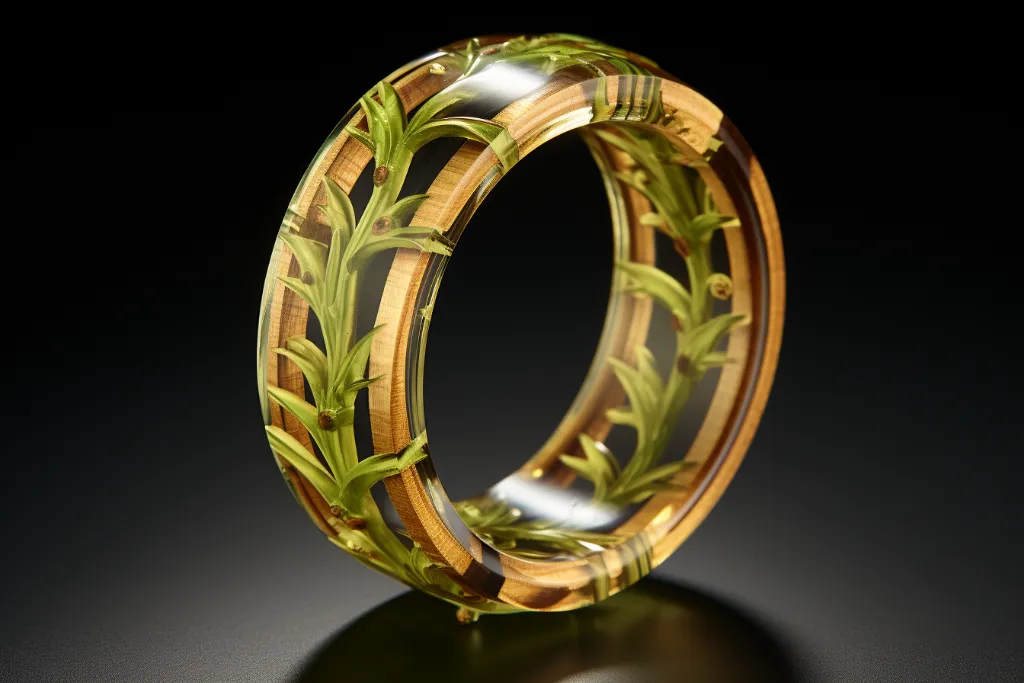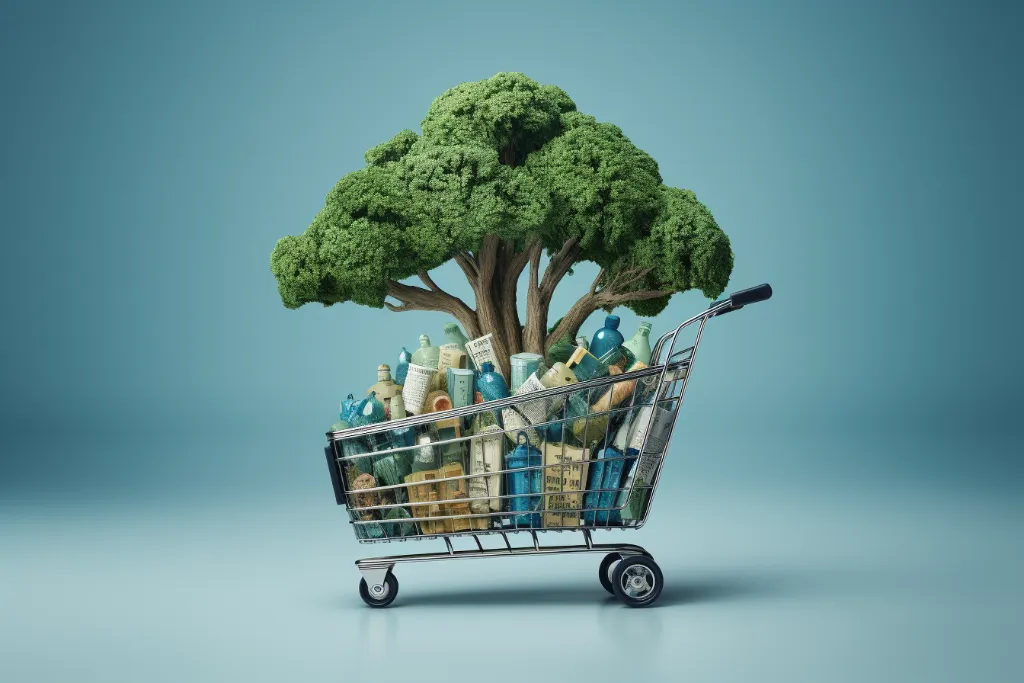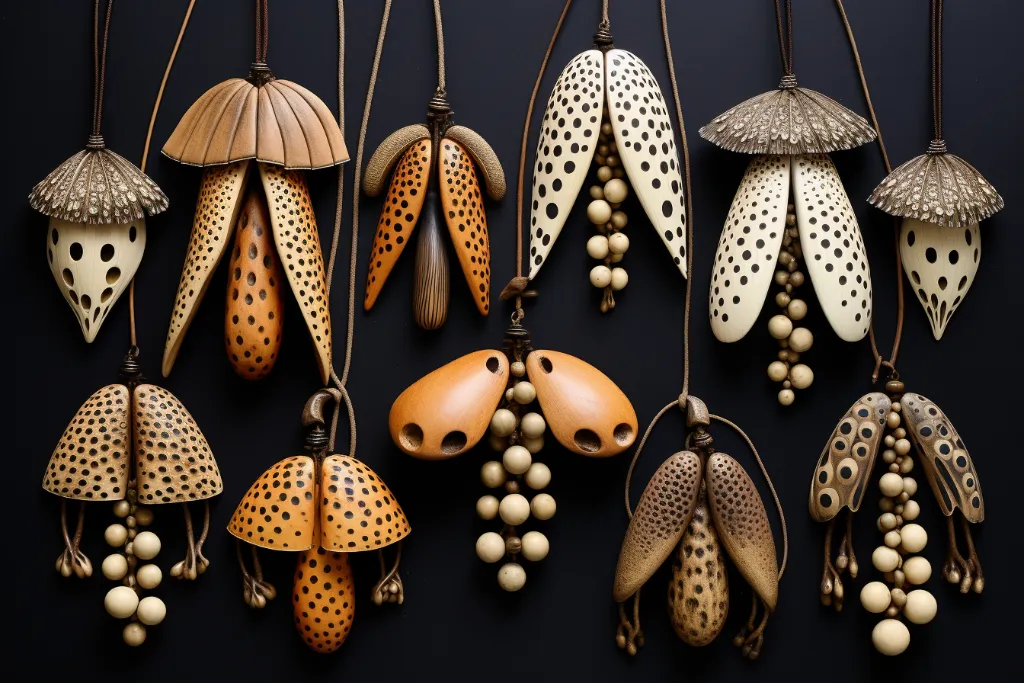Table of Contents
The Rise of Biodegradable Jewelry
Exploring the growing demand for sustainable and eco-friendly products
The jewelry industry has traditionally relied on materials such as gold, silver, and gemstones, which are often mined and processed using harmful techniques. However, in recent years, there has been a significant shift towards sustainable and eco-friendly products.
One of the emerging trends in the jewelry industry is the use of biodegradable materials.
Consumers are becoming more conscious of the environmental impact of their purchases and are actively seeking out alternatives that align with their values.
Biodegradable jewelry refers to pieces that are made from materials that can naturally decompose over time, leaving little to no negative impact on the environment. This concept has gained traction due to its ability to address the growing concerns about sustainability and reduce the industry’s carbon footprint.

Introduction to the concept of biodegradable materials in jewelry making
Biodegradable materials in jewelry making refer to substances that can break down naturally through biological processes, such as microbial action or enzymatic reactions. These materials are derived from renewable sources and can return to the earth without causing harm or leaving behind any toxic residues.
The use of these materials in jewelry making offers a sustainable alternative to traditional materials, which often involve destructive mining practices and contribute to environmental degradation. By embracing biodegradable materials, designers and brands are taking a step towards reducing their environmental impact and supporting a more responsible and ethical industry.
Examples of successful brands embracing this trend
Numerous jewelry brands have recognized the growing demand for sustainable and eco-friendly products and have embraced the use of biodegradable materials in their collections. These brands are leading the way in promoting environmentally conscious practices and offering consumers a guilt-free choice when it comes to jewelry.
One such brand is Palaemon, known for its jewelry made from materials such as wood, bamboo, and plant-based resins. Palaemon’s designs are not only aesthetically pleasing but also environmentally friendly, allowing consumers to express their style without compromising their values.
Another brand that has successfully embraced these versatile materials is EcoGems, which creates jewelry using biodegradable polymers derived from cornstarch. These materials have properties similar to traditional plastics but can break down naturally over time, making them a sustainable choice for conscious consumers.
Understanding Biodegradable Materials
Definition and characteristics of biodegradable materials
Biodegradable materials are substances that can be broken down by natural processes into simpler compounds, such as water, carbon dioxide, and biomass. These materials are typically derived from renewable sources, such as plants or microorganisms, and can decompose without leaving behind any harmful residues.
Characteristics of biodegradable materials include their ability to degrade within a specific timeframe, often influenced by environmental conditions such as temperature, moisture, and the presence of microorganisms. These materials are designed to mimic the natural degradation processes of organic matter, ensuring that they do not accumulate in the environment and contribute to pollution.
Overview of different types of biodegradable materials used

There are several types of biodegradable materials used in jewelry making, each with its unique properties and characteristics. Some of the most common materials include:
- Wood:
Wood has been used in jewelry making for centuries and is a popular choice for its natural beauty and sustainability. It is a renewable resource that can be responsibly harvested, and when properly treated, it can withstand the test of time. - Bamboo:
Bamboo is another renewable material that has gained popularity in jewelry making. It is lightweight, durable, and has a unique texture that adds an organic touch to jewelry designs. - Plant-based resins:
Plant-based resins, derived from sources such as tree sap and vegetable oils, are versatile materials used in jewelry making. These resins can be molded into various shapes and colors, offering designers the freedom to create unique and innovative pieces. - Biodegradable polymers:
Biodegradable polymers, often derived from renewable sources such as cornstarch or cellulose, are increasingly being used in jewelry making. These polymers have properties similar to traditional plastics but can degrade naturally, making them a sustainable alternative.
Advantages and limitations of utilizing these materials in the industry
Utilizing biodegradable materials in the jewelry industry offers several advantages, both from an environmental and consumer perspective.

Environmental advantages:
- Reduced carbon footprint:
Biodegradable materials are typically derived from renewable sources, which require fewer resources and have a lower carbon footprint compared to traditional materials such as gold or silver. By using these materials, jewelry designers can contribute to reducing greenhouse gas emissions and combat climate change. - Reduced waste generation:
Biodegradable materials can break down naturally, leaving behind minimal waste. This reduces the amount of jewelry waste that ends up in landfills or oceans, where it can take centuries to decompose. - Preservation of natural resources:
By using biodegradable materials, the demand for traditional materials, which often require destructive mining practices, can be reduced. This helps to preserve natural resources, protect ecosystems, and minimize the negative impact on biodiversity.
Consumer advantages:
- Ethical and sustainable choices:
Biodegradable jewelry offers consumers an ethical and sustainable choice when it comes to accessorizing. By opting for jewelry made from bio-degradable materials, consumers can support brands that prioritize sustainability and contribute to a more responsible industry. - Unique and innovative designs:
Biodegradable materials allow for unique and innovative designs that are not limited by the constraints of traditional materials. Designers can experiment with shapes, textures, and colors, offering consumers a wide range of options to express their personal style.
However, it is important to acknowledge that there are limitations to utilizing biodegradable materials in the industry. These limitations include:
- Durability:
Biodegradable materials may not be as durable as traditional materials like gold or silver. They may be prone to scratches, discoloration, or breakage over time, requiring more careful handling and maintenance. - Limited availability:
Some biodegradable materials, especially those derived from renewable sources, may have limited availability. This can impact the scalability of production and the ability to meet the growing demand for biodegradable jewelry. - Higher production costs:
Biodegradable materials may require specialized production techniques and equipment, which can increase production costs compared to traditional materials. This may result in higher price points for jewelry.
Despite these limitations, the growing demand for sustainable and eco-friendly products, coupled with advancements in material science, is driving the industry’s focus toward biodegradable materials.
Innovations in Biodegradable Jewelry
Highlighting the latest advancements and techniques in creating biodegradable jewelry
The use of biodegradable materials in jewelry making has paved the way for innovative techniques and advancements in the industry. Designers and manufacturers are continuously exploring new ways to create biodegradable jewelry that is both aesthetically pleasing and environmentally friendly.
One of the latest advancements is the development of 3D printing technology for biodegradable jewelry. This technique allows designers to create intricate and customized pieces using biodegradable polymers. 3D printing also reduces material waste, as it only uses the exact amount of material required for each piece, minimizing resource consumption.
Another innovative technique is biofabrication, which involves growing jewelry pieces using living organisms, such as bacteria or fungi. These organisms are manipulated to create intricate structures and patterns, resulting in unique and biodegradable jewelry. Biofabrication not only offers a sustainable alternative to traditional manufacturing methods but also opens up new possibilities for designers to create one-of-a-kind pieces.
Showcasing unique designs and styles made possible with these materials

Biodegradable materials have expanded the creative possibilities for jewelry designers, allowing them to create unique designs and styles that are not limited by the constraints of traditional materials. From organic shapes inspired by nature to bold and vibrant colors, biodegradable jewelry offers a wide range of options to suit diverse tastes and preferences.
One example of unique designs made possible with biodegradable materials is seed jewelry. These pieces incorporate actual plant seeds, such as acorns or sunflower seeds, into the design. The seeds can be combined with biodegradable polymers to create pendants, earrings, or bracelets that serve as a reminder of the importance of nature and sustainability.
Another example is wooden jewelry. Wood has a natural warmth and texture that adds a unique touch to jewelry designs. From delicate wooden rings to statement necklaces, wooden jewelry offers a rustic and eco-friendly alternative to traditional metal-based pieces.
Examining the use of natural elements and sustainable practices in the production process
In addition to utilizing biodegradable materials, the production process of biodegradable jewelry often incorporates sustainable practices and the use of natural elements. These elements further enhance the eco-friendly nature of biodegradable jewelry and resonate with consumers who value conscious and ethical choices.
One sustainable practice commonly adopted in the production of biodegradable jewelry is upcycling. Upcycling involves transforming waste materials or unwanted objects into new, higher-value products. In the context of jewelry making, upcycling can involve repurposing materials such as discarded wood, glass, or even metal components to create unique and environmentally friendly pieces.
Another sustainable practice is sourcing materials locally. By sourcing materials locally, designers can reduce the carbon footprint associated with transportation and support local communities. This practice also ensures transparency and accountability in the supply chain, as designers can have direct oversight of the materials’ origins and production processes.
The use of natural dyes is another sustainable practice that aligns with the production of biodegradable jewelry. Natural dyes, derived from plant-based sources, offer an eco-friendly alternative to synthetic dyes, which often contain harmful chemicals. By using natural dyes, designers can create vibrant and colorful pieces without compromising the environment or consumer health.
Environmental Benefits of Biodegradable Jewelry
Discussing the positive impact of biodegradable materials on the environment

The use of biodegradable materials in jewelry-making offers several environmental benefits, making it a sustainable choice for conscious consumers. These benefits include:
- Reduced landfill waste:
Biodegradable materials can break down naturally, leaving behind minimal waste. This reduces the amount of jewelry waste that ends up in landfills, where it can take centuries to decompose. By opting for biodegradable jewelry, consumers can contribute to reducing the burden on landfill sites and minimizing the environmental impact of discarded jewelry. - Reduced pollution:
Traditional jewelry making often involves the use of chemicals, such as mercury or cyanide, for gold or silver extraction. These chemicals can pollute waterways and soil, posing a significant risk to ecosystems and human health. Biodegradable materials, on the other hand, do not require such harmful extraction techniques, reducing the pollution associated with jewelry production. - Conservation of natural resources:
Biodegradable materials are typically derived from renewable sources, such as plants or microorganisms, which require fewer resources and have a lower environmental impact compared to traditional materials. By using biodegradable materials, the demand for traditional materials, which often involve destructive mining practices, can be reduced. This helps to conserve natural resources, protect ecosystems, and preserve biodiversity.
How these materials contribute to reducing pollution and waste in the industry
The jewelry industry has historically been associated with environmental pollution and waste generation due to its reliance on traditional materials and production techniques. However, the use of biodegradable materials in jewelry-making offers a promising solution to address these issues.
By utilizing biodegradable materials, the jewelry industry can significantly reduce pollution and waste generation throughout the entire production process. This includes:
- Extraction and processing:
Traditional materials, such as gold or silver, often require intensive extraction processes that involve the use of harmful chemicals. These chemicals can contaminate water sources, soil, and ecosystems, leading to long-term environmental damage. Biodegradable materials, on the other hand, can be derived from renewable sources using less energy and without the need for toxic chemicals, reducing the pollution associated with extraction and processing. - Manufacturing and production:
The manufacturing and production of traditional jewelry often involve excessive resource consumption and waste generation. Biodegradable materials, however, can be molded and shaped using sustainable techniques, such as 3D printing or biofabrication, which minimize material waste and resource consumption. This reduces the overall environmental impact of the manufacturing process and helps to conserve resources. - End-of-life disposal:
Traditional jewelry, when discarded, often ends up in landfills or oceans, where it can take centuries to decompose. This leads to environmental pollution and contributes to the accumulation of waste. Biodegradable jewelry, on the other hand, can naturally decompose over time, leaving minimal residues and reducing the burden on landfills. This ensures that the end-of-life disposal of jewelry does not contribute to long-term environmental pollution.
Aligning the values of conscious consumers with biodegradable jewelry options
The increasing demand for sustainable and eco-friendly products has led to a shift in consumer preferences and values. Conscious consumers are actively seeking out options that align with their values and contribute to a more sustainable future. Biodegradable jewelry offers an ideal choice for consumers who prioritize sustainability and eco-consciousness.
By opting for biodegradable jewelry, consumers can ensure that their accessory choices reflect their commitment to the environment. Biodegradable materials offer a renewable and sustainable alternative to traditional materials, reducing the environmental impact of the jewelry industry. This alignment between consumer values and product offerings strengthens the connection between brands and their target audience, fostering loyalty and trust.
Challenges and Future Outlook
Addressing the challenges faced by the biodegradable jewelry industry
While the use of biodegradable materials in jewelry making presents numerous benefits, there are also challenges that need to be addressed for the industry to thrive. Some of the challenges faced by the biodegradable jewelry industry include:

- Limited scalability:
Some biodegradable materials, especially those derived from renewable sources, may have limited availability or scalability. This can pose challenges for brands looking to meet the growing demand for biodegradable jewelry. - Durability concerns:
Biodegradable materials may not be as durable as traditional materials like gold or silver. This can raise concerns among consumers about the longevity and lifespan of biodegradable accessories. - Higher production costs:
The production costs associated with biodegradable materials may be higher compared to traditional materials, due to specialized techniques and equipment required. This can result in higher price points for biodegradable jewelry, which may limit its accessibility to a broader consumer base.
Identifying potential areas for improvement and further research
To overcome the challenges faced by the biodegradable jewelry industry and drive its growth, there are several areas for improvement and further research. These include:
- Development of new materials:
Continued research and development of new materials with enhanced durability and aesthetic properties can help address consumer concerns and expand the design possibilities for biodegradable jewelry. - Scalability and availability:
Efforts should be made to increase the scalability and availability of biodegradable materials to meet the growing demand for sustainable jewelry. This can involve exploring new methods of sourcing, manufacturing, and processing these materials. - Cost reduction:
Research into cost-effective production techniques and processes can help reduce the production costs associated with biodegradable jewelry. This can make sustainable options more accessible to a wider consumer base.
Predictions for the future of biodegradable materials in jewelry making
The future of biodegradable materials in jewelry making looks promising, with increasing consumer demand for sustainable and eco-friendly products. As consumer awareness and consciousness about environmental issues continue to grow, the jewelry industry is likely to witness a significant shift toward biodegradable materials.
Advancements in material science and manufacturing techniques will further enhance the durability and design possibilities of biodegradable jewelry. This, coupled with increased scalability and availability of biodegradable materials, will enable designers and brands to meet the growing demand for sustainable options.
Furthermore, collaborations between jewelry designers, material scientists, and environmental experts will drive innovation and research in the field of biodegradable materials. This interdisciplinary approach will contribute to the development of new materials and techniques, ensuring the continuous improvement and evolution of the biodegradable industry.
Supporting Sustainable Practices
Encouraging consumers to support brands that prioritize sustainability

One of the most effective ways for consumers to support sustainable practices in the jewelry industry is by consciously choosing to purchase from brands that prioritize sustainability. By supporting these brands, consumers send a clear message to the industry that sustainability is a priority and can drive positive change.
When considering purchasing jewelry, consumers should look for brands that have a strong commitment to sustainability. Such as using biodegradable materials, implementing ethical production practices, and supporting local communities. By doing so, consumers can contribute to the growth of the biodegradable industry and encourage other brands to follow suit.
How to identify and choose biodegradable jewelry options
Identifying and choosing biodegradable jewelry options can be a challenge, as not all brands clearly label their products as biodegradable. However, there are several indicators and factors to consider when making a sustainable jewelry purchase:
- Materials:
Look for accessories made from biodegradable materials, such as wood, bamboo, or plant-based resins. These materials are more likely to be biodegradable compared to traditional materials like gold or silver. - Certifications and labels:
Some brands may have certifications or labels indicating their commitment to sustainability. Look for certifications such as “Certified Biodegradable” or “Eco-friendly” to ensure that the accessory meets specific environmental standards. - Transparency:
Brands that prioritize sustainability often provide transparent information about their production processes, materials sourcing, and environmental impact. Look for brands that openly share this information to make an informed decision.
The role of certifications and labels in ensuring transparency and accountability
Certifications and labels play a crucial role in ensuring transparency and accountability in the jewelry industry. They provide consumers with the necessary information to make informed choices and support brands that prioritize sustainability.

Some of the certifications and labels to look out for when purchasing jewelry include:
- Certified Biodegradable:
This certification indicates that the jewelry has undergone testing and meets specific biodegradability standards. It ensures that the materials used in the jewelry can break down naturally, minimizing environmental impact. - Fairtrade:
The Fairtrade label indicates that the jewelry has been produced using ethical and sustainable practices. It ensures that the workers involved in the production process are paid fair wages and work in safe conditions. - Eco-friendly:
This label suggests that the jewelry has been produced with minimal environmental impact. It may indicate the use of biodegradable materials or sustainable production practices.
By looking for these certifications and labels, consumers can make more informed choices and support brands that prioritize sustainability and accountability.
